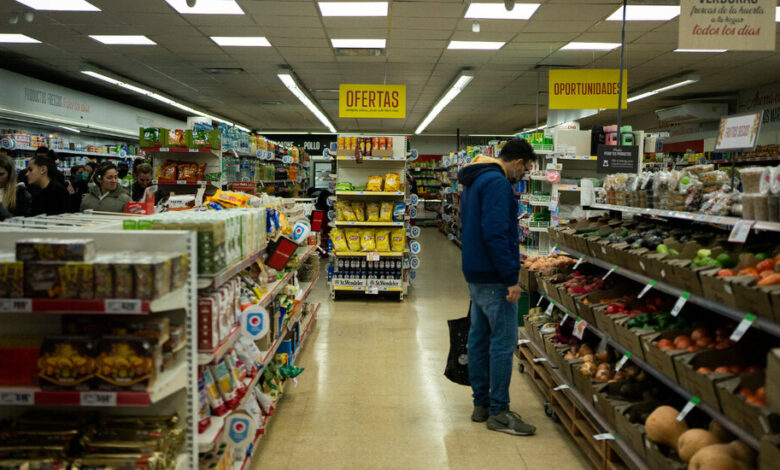Think 9% Inflation Is Bad? Try 90%.

BUENOS AIRES — Eduardo Rabuffetti is an Argentine who has been to the United States once, his 1999 honeymoon in Miami. Yet he probably knows the $100 bill better than most Americans.
He says he can pick out a counterfeit by touch. He can tell you exactly what $100,000 looks like. (Ten half-inch stacks, small enough to hold in one hand.) And on numerous occasions, he has walked down the streets of Buenos Aires with tens of thousands of U.S. dollars tucked into his jacket.
That is because Mr. Rabuffetti, a property developer who has built two office towers and a house here, bought the land for each of those buildings in $100 bills.
“Here, if you don’t actually see the money, nobody signs anything,” he said. “After the number of crises we’ve been through, let’s just say you get used to it.”
It is not just Mr. Rabuffetti. Nearly every big purchase in Argentina — land, houses, cars, expensive art — is done in tall stacks of U.S. currency. To save up, Argentines stuff bundles of American bills into old clothes, beneath floor boards and in bombproof safe deposit boxes past nine locked gates and five stories beneath the ground.

Eduardo Rabuffetti, a property developer, has bought land for projects with cash. “Here, if you don’t actually see the money, nobody signs anything,” he said.
Argentines hold so much U.S. currency — experts believe perhaps more than anywhere outside the United States — sometimes it gets thrown away by mistake. Last month, passers-by found tens of thousands of dollars blowing around at an Argentine dump.
The dollar is king in Argentina because the Argentine peso is disintegrating in value, particularly over the past month. One year ago, about 180 pesos could buy $1 on the widely used black market. Now it takes 298 pesos to buy a buck. With the peso plummeting, prices are soaring to keep up. Many economists expect inflation here, already at 64 percent this year, to hit 90 percent by December.
It is one of the country’s worst economic crises in decades, and that is saying something for Argentina.
As countries across the world try to cope with rising prices, there is perhaps no major economy that understands how to live with inflation better than Argentina.
The country has struggled with rapidly rising prices for much of the past 50 years. During a chaotic stretch in the late 1980s, inflation hit a nearly unbelievable 3,000 percent and residents rushed to snatch up groceries before clerks with price guns could make their rounds. Now high inflation is back, exceeding 30 percent every year since 2018.
To understand how Argentines cope, we spent two weeks in and around Buenos Aires, talking to economists, politicians, farmers, restaurateurs, realtors, barbers, taxi drivers, money changers, street performers, street vendors and the unemployed.
The economy is not always the best conversation starter, but in Argentina, it animated just about everyone, eliciting curses, deep sighs and informed opinions about monetary policy. One woman happily showed off her hiding spot for a wad of U.S. dollars (an old ski jacket), another explained how she stuffed cash into her bra to buy a condo, and a Venezuelan waitress wondered whether she had immigrated to the right country.
One thing became strikingly clear: Argentines have developed a highly unusual relationship with their money.
They spend their pesos as quickly as they get them. They buy everything from TVs to potato peelers in installments.They don’t trust banks. They hardly use credit. And after years of constant price hikes, they are left with little idea of how much things should cost.
Argentina shows that people will find a way to adapt to years of high inflation, living in an economy that is impossible to fathom almost anywhere else in the world. Life is especially manageable for those with the means to make the upside-down system work. But all those striking workarounds mean that few who have held political power during years of economic distress have found themselves paying a real price.
“We ask ourselves the same thing: How is society allowing these things to happen?” said Juan Piantoni, the head of Ingot, a safe-deposit-box company where business is booming as Argentines pay to stash their cash. “At this moment, I think we’re on the eve of a situation that could lead to a major crisis,” he added. “No one has lit the fuse yet. But the day that happens, we’ll see what we’re up against.”
So far, things have remained largely calm. Wages for many jobs are rising at nearly 50 percent a year. Landlords can raise rents at similar rates. And millions of Argentines use the black market to evade government restrictions on buying U.S. dollars.
The result is that in the wealthier areas of Argentina’s capital, construction continues apace and restaurants and bars are packed. The next dinner reservation for two at Anchoita, one of the city’s hippest restaurants, is in January 2023.
In poorer neighborhoods, people collect scrap cardboard to sell, pool their money for food and swap used goods to avoid the peso altogether. Argentina’s poor typically don’t have jobs with automatic wage increases, and they certainly don’t have extra cash to buy U.S. dollars. That means they are left making few pesos while everything around them gets much, much more expensive.About 37 percent of Argentines now live in poverty, up from 30 percent in 2016.
8 Signs That the Economy Is Losing Steam
Worrying outlook. Amid persistently high inflation, rising consumer prices and declining spending, the American economy is showing clear signs of slowing down, fueling concerns about a potential recession. Here are other eight measures signaling trouble ahead:
Retail sales. The latest report from the Commerce Department showed that retail sales fell 0.3 percent in May, and rose less in April than initially believed.
Consumer confidence. In June, the University of Michigan’s survey of consumer sentiment hit its lowest level in its 70-year history, with nearly half of respondents saying inflation is eroding their standard of living.
The housing market. Demand for real estate has decreased, and construction of new homes is slowing. These trends could continue as interest rates rise, and real estate companies, including Compass and Redfin, have laid off employees in anticipation of a downturn in the housing market.
Start-up funding. Investments in start-ups have declined to their lowest level since 2019, dropping 23 percent over the last three months, to $62.3 billion.
The stock market. The S&P 500 had its worst first half of a year since 1970, and it is down nearly 19 percent since January. Every sector of the index beyond energy is down from the beginning of the year.
Copper. A commodity seen by analysts as a measure of sentiment about the global economy — because of its widespread use in buildings, cars and other products — copper is down more than 20 percent since January, hitting a 17-month low on July 1.
Oil. Crude prices are up this year, in part because of supply constraints resulting from Russia’s invasion of Ukraine, but they have recently started to waver as investors worry about growth.
The bond market. Long-term interest rates in government bonds have fallen below short-term rates, an unusual occurrence that traders call a yield-curve inversion. It suggests that bond investors are expecting an economic slowdown.
On July 2, Argentina’s economic minister resigned. Over the next 26 days, the peso’s value dropped 26 percent. Then President Alberto Fernandez fired the new economic minister. It was the 21st time that an Argentine economic minister lasted two months or less.
Argentina’s recent bout with hyperinflation is linked to the same things that have driven up prices worldwide, including the war in Ukraine, supply-chain constraints and big increases in public spending.
But many economists believe Argentina’s inflation is also self-inflicted. In short, the country spends far more than it takes in to fund free or deeply subsidized health care, universities, energy and public transportation. To make up for the shortfall, it prints more pesos.
The International Monetary Fund, which is owed $44 billion from Argentina, has asked the government to cut its deficit and pass stricter monetary policies. On Wednesday, the new minister, Sergio Massa, made one of the most significant steps in years when he pledged that Argentina would stop printing pesos to fund its budget.
Yet many Argentines were skeptical that the country was ready to make the tough choices necessary.
“We might need the patient to have a heart attack before the family says, ‘Let’s do the surgery,’” said Hugo Alconada Mon, one of the country’s top investigative journalists and a best-selling author who spent almost the last of his savings recently on car repairs. “But how many people will end up in poverty because of that? How many people will leave the country?”
Abandoning price tags
Argentines are hoping the current moment does not spiral into a disaster like 2001, when there was a run on the banks.
That year, it became clear that foreign investors believed the Argentine peso was worth far less than the government’s official rate, and Argentines rushed to get their money before it was lost. Instead, the government halted withdrawals — and then gave them all a haircut, reducing everyone’s savings in a sudden devaluation. The president resigned and left the government offices in a helicopter to avoid the angry crowds in the regal square out front, Plaza de Mayo.
Two decades later, the angry crowds are still in Plaza de Mayo. Thousands of Argentines gathered there last month to protest the soaring inflation.
Ana Mabel was on the outskirts of the crowd, mixing peanuts and caramelized sugar in a metal vat. She was selling bags of candied peanuts for 200 pesos each, or about 70 cents; she had charged 150 pesos a week earlier. But that increase hardly kept up with her costs. Everything she needed had gotten pricier in just the past few weeks: the peanuts, the sugar, the oil, the gas tank, and the plastic baggies to package the treat. She has five children to support, and for the first time, she had taken on debt.
“Nothing regulates the prices,” she said, frustrated, slowly turning the peanuts in the vat. “The businessmen don’t want it. The government can’t. And that all falls on us.”
For Argentines, it is an old story. In 2017, prices had risen so much that Argentina doubled the size of its largest bank note to 1,000 pesos, then worth about $58 on the black market. Now that note is worth about $3.45 — about the price of a Big Mac. An iPhone can now cost more than 1 million pesos.
Many Argentines have lost their bearings on value. Menus are constantly changed. Taxi meters are frequently adjusted. And price tags are often outdated.
Oscar Benitez runs a meticulously organized hardware store the size of a large walk-in closet. He sells 80,000 different products, and he hardly knows the price of any of them.
That is because they change every few days, updated in a running list sent by his suppliers that he checks on his computer for every sale. He has largely abandoned price tags.
He shows a pair of scissors that the supplier says should now cost 600 pesos. “A month ago, it was worth 400 pesos,” he said, consulting his list. “A year ago, it was worth 120 pesos.”
He looked exasperated. “It’s sad. But for me, it was always like this,” he said. “If I wasn’t 51 years old, I’d be in the United States, which is what I’m now trying to make happen for my daughters.”
Prices are fluctuating so much that in recent weeks many companies have halted sales to see where prices settle, making it difficult to find certain items, including cooking oil and car parts. Some farmers are also holding onto their wheat and soybeans, betting prices will rise — and blunting the economic benefits of a commodity boom that should benefit an exporter like Argentina.
At a small shop in downtown Buenos Aires, Noelia Mendoza was selling her last stock of toilet paper. Her suppliers said they had no more, so she had raised her prices. A pack of four single-ply rolls now cost 290 pesos, or $1, up 50 percent from a month earlier. “There is going to be a shortage,” she said.
Her friend standing nearby, Carla Cejas, chimed in: “I never understood the bidet until now.”
A duffel bag full of 10,000 $100 bills
Ignacio Jauand, a 34-year-old publicist, buys everything he can in installments, including his bed, his clothes, a PlayStation 5 and a potato peeler.
It’s not that he can’t afford them. It’s that he’s betting the value of the peso will fall. If he’s right, his final payments cost significantly less. That bet, he said, has always paid off. “The last installment I paid for the TV or the fridge cost two or three McDonald’s combos,” he said.
“Buying stuff is how you beat inflation,” he added.
That is the mantra of Argentina. Pesos disintegrate in value, so you better spend them as quickly as you can.
People go out to eat or buy appliances, art or cars, while shop owners stock up on inventory, betting prices will only go up. “When I think of my savings in pesos, I say, ‘Let’s pay for a trip, let’s renew something in the house, let’s buy stuff,’” said Eduardo Levy Yeyati, an Argentine economist and visiting professor at Harvard University. “Otherwise I feel like I’m losing money every day by keeping it in the bank.”
The State of Jobs in the United States
Employment gains in July, which far surpassed expectations, show that the labor market is not slowing despite efforts by the Federal Reserve to cool the economy.
- July Jobs Report: U.S. employers added 528,000 jobs in the seventh month of the year. The unemployment rate was 3.5 percent, down from 3.6 percent in June.
- Care Worker Shortages: A lack of child care and elder care options is forcing some women to limit their hours or has sidelined them altogether, hurting their career prospects.
- Downsides of a Hot Market: Students are forgoing degrees in favor of the attractive positions offered by employers desperate to hire. That could come back to haunt them.
- Slowing Down: Economists and policymakers are beginning to argue that what the economy needs right now is less hiring and less wage growth. Here’s why.
Perhaps Argentines’ favorite things to buy? Dollars.
Argentina’s central bank estimates that Argentine households and nonfinancial firms hold more than $230 billion in foreign financial assets, mostly denominated in U.S. currency.Most of that money is held in international bank accounts, but some is also stashed in safes and hiding places across the country.
That dependence on the dollar is bad for the peso, so the government restricts Argentines from buying more than $200 in U.S. currency each month. For that amount, Argentines can use the official government exchange rate, which says each U.S. dollar is worth about 130 pesos.
But a different exchange rate — used for Western Union wires, certain corporate transactions, and the black market — values the peso at less than half that: Each dollar is now worth about 300 pesos. (Because this rate is a truer measure of the open market’s view of the peso, we used it to convert values in this article.)
In downtown Buenos Aires, men and women dubbed “arbolitos,” or little trees, stand on street corners hawking dollars. They lead buyers to so-called caves to change the money in private.
It’s all illegal, but police standing nearby don’t seem to mind. Many use the market themselves.
Juan, a money changer who delivers wads of cash on his motorbike, said three of his regular customers are police officers. Even so, he agreed to speak on the condition that only his first name be used.
Money changers and cave managers estimated the black market moves $3 million to $4 million a day. Those dollars underpin much of the economy here.
Yanina Arias, a Buenos Aires real-estate agent, said she has completed hundreds of deals over her 10-year career, but never one in pesos. Sellers often require “dollar bills without stains, without rips, and that are big-faced,” Ms. Arias said. “Small-faced bills are not accepted.”
The face in question is Benjamin Franklin’s. The black market generally offers 3 percent more for newer $100 notes with Mr. Franklin’s enlarged portrait because they are harder to counterfeit.
Seven Argentines described paying for properties in cash, but few were willing to allow their names to be printed because they were worried about being audited.
To head to the bank to close the deal, they described stuffing tens of thousands of dollars down their pants and into grocery bags full of produce. Ms. Arias said wealthier people have hired armored trucks.
A financial-services worker in Buenos Aires said that when she sold her family’s farm for $1 million a few years ago, the buyer handed her a duffel bag full of 10,000 $100 bills. Later, when she bought her apartment, she put $100,000 of the cash into the pockets of an oversized coat and hustled to the buyers’ home. The sellers, an older couple, insisted on counting each bill by hand.
Trading milk for diapers
After Adela Castillo and her husband lost their jobs during the pandemic — she was a caretaker and he worked in shipping — they took a big risk. They converted their home in one of Buenos Aires’s poorest neighborhoods into a shop selling cement, limestone, paint and plasterboard.
At first, it was paying off. The government was building new affordable housing in the neighborhood, and it became a big buyer. To keep up, she needed a forklift. And to buy one, she needed $15,000 in cash.
A bank would never make that kind of loan, but luckily, she had a family friend who had that much stashed away. “A huge favor,” she said. “Nobody lends you money like that.”
She bought the forklift. “It helped a ton,” she said. Then the value of the peso continued to plummet. “He wants me to pay back in dollars. He doesn’t want pesos,” she said. With each decline in the value of the peso, her debt has effectively grown bigger.
“It’s a screwed-up situation,” she said, standing outside her shop, limestone dust in her hair and down her fleece. She was not sure how she would pay it off. “We’re treading water,” she said. “We’re fighting.”
With the peso losing so much value, some poor Argentines are trying to avoid it altogether.
Silvina López, 37, was standing in the biting cold with her infant. She needed diapers but she was broke. After a stroke, Ms. López was blind in one eye and didn’t work, while her husband was a construction laborer when it was sunny. But his wages — about $7 a day — hadn’t increased while the prices did.
But here, next to a bus stop in the poor suburb of Lomas de Zamora, she didn’t need pesos. Instead, she had sacks of powdered milk, handouts from the government that she could trade in order to make sure her 1-month-old, Milagro, or Miracle in Spanish, had diapers.
Another woman had set up shop on the street corner to barter, and she traded Ms. López a 12-pack of diapers, two bags of sugar and a box of cookies for the powdered milk. Ms. López’s 8-year-old daughter, Mia, immediately tore into the cookies.
“My family, my siblings, they all come here,” she said. “They have lots of children, too.”
During the recession that accompanied the 2001 run on the banks, a half-million people were regularly meeting in so-called “trueque” clubs, or bartering exchanges, to swap goods without pesos. The clubs largely disintegrated over the years, but with inflation again soaring, they are making a comeback.
On a recent Sunday, nearly 100 people hustled among two dozen tables, swapping their wares: used clothes, cleaning supplies, homemade pizza dough, insecticide, fried quince pastries. To facilitate the trades, they used “créditos,” the club’s own currency, printed onto white paper.
Women clutched handfuls of the notes as they shopped at their neighbors’ tables. They all said they preferred the crédito to the peso.
At one point, an organizer who was selling Avon makeup, Karina Sanchez, paused the cumbia music to make an announcement: They were exchanging older, smaller denomination créditos for newer, larger ones. She showed much older notes worth one-half a crédito. Last year, they introduced a 1,000-crédito note.
Yes, Ms. Sanchez said, the crédito was experiencing inflation, too.
Natalie Alcoba contributed reporting from Buenos Aires.





